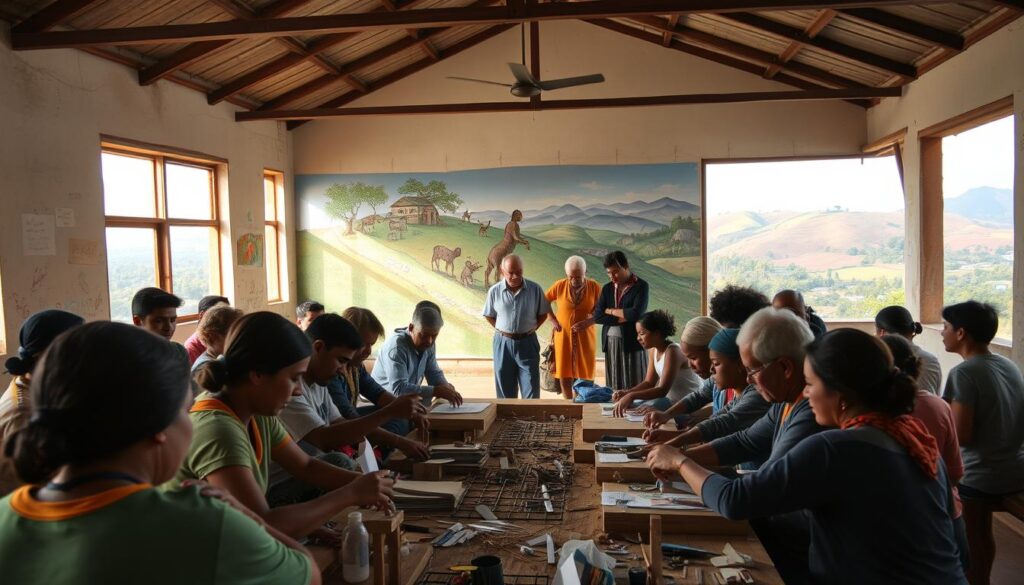Can community development programs truly drive positive change? Empowering communities is a vital aspect of Family and Community Services, enabling individuals and groups to take control of their lives and make informed decisions. Community development programs play a crucial role in this empowerment by providing the necessary tools and resources.
By focusing on local capacity building engineering, communities can leverage their existing strengths to address challenges such as limited access to healthcare services and high unemployment rates. This approach fosters resilience and promotes sustainable development. For more insights on empowering communities, visit empowering communities through development.
Key Takeaways
- Community development programs are crucial for empowering communities.
- Local capacity building engineering helps communities address their challenges.
- Empowering communities leads to positive change and sustainable development.
- Strong social networks and community organizations are vital assets.
- Limited funding is a significant challenge for community programs.
What is Local Capacity Building Engineering?
The concept of local capacity building engineering revolves around enhancing the ability of communities to manage their infrastructure needs. This approach focuses on empowering communities through sustainable infrastructure projects and vocational training initiatives, enabling them to develop and maintain their own infrastructure.
Definition and Key Concepts
Local capacity building engineering is defined as the process of enhancing the technical, social, and economic capacity of communities to manage their infrastructure and development projects effectively. Key concepts include community engagement, participatory planning, and the development of local skills through vocational training.
Assessing community needs is a crucial step in this process, as it helps identify the strengths, weaknesses, opportunities, and challenges facing a particular community. This assessment informs the development of targeted vocational training initiatives and sustainable infrastructure projects that address specific community needs.
Importance in Community Development
Local capacity building engineering plays a vital role in community development by fostering self-reliance and sustainability. By empowering communities to manage their infrastructure needs, local capacity building engineering contributes to the overall well-being and resilience of communities.
The importance of local capacity building engineering can be seen in its ability to promote sustainable development and improve the quality of life for community members. For more information on the role of engineering in capacity building, visit the World Federation of Engineering Organizations.
| Key Components | Description | Benefits |
|---|---|---|
| Sustainable Infrastructure Projects | Projects that are environmentally friendly and sustainable | Reduced environmental impact, cost-effective |
| Vocational Training Initiatives | Training programs that enhance local skills | Empowered community, improved infrastructure management |
| Community Engagement | Involvement of community members in planning and decision-making | Increased community ownership, more effective projects |
The Role of Engineers in Community Empowerment
By applying their technical expertise, engineers can drive meaningful change in communities, enhancing their capacity for self-improvement. This is achieved through a combination of urban planning solutions and civil engineering workshops, which are tailored to address specific community needs.

Engineering Expertise and Community Needs
Engineers bring a unique set of skills to community development projects. Their expertise in designing and implementing infrastructure projects is crucial for meeting community needs. For instance, engineering innovation can lead to improved water management systems, sustainable buildings, and efficient transportation networks.
The alignment of engineering expertise with community needs is critical for the success of empowerment initiatives. This involves understanding the specific challenges faced by a community and devising solutions that are both effective and sustainable.
Success Stories from the Field
There are numerous examples of engineers making a positive impact in communities. For example, civil engineering workshops have been instrumental in educating community members about sustainable construction practices, enabling them to participate actively in development projects.
One notable success story involves a community that, with the help of engineers, developed a sustainable water conservation system. This not only improved access to clean water but also fostered a sense of community ownership and pride in the project.
Such initiatives demonstrate the potential of collaborative efforts between engineers and communities to drive meaningful change and empower local residents.
Core Principles of Capacity Building
The core principles of capacity building revolve around creating sustainable and inclusive engineering solutions that benefit local communities. Effective capacity building is essential for empowering communities and ensuring the long-term success of engineering projects.
Inclusivity and Participation
Inclusivity and participation are fundamental to successful capacity building. By engaging all stakeholders, including local residents, in the planning and decision-making process, engineering projects can better address community needs and foster a sense of ownership among community members.
Key strategies for promoting inclusivity include:
- Conducting community outreach and engagement initiatives
- Ensuring that project plans are accessible and understandable to all stakeholders
- Fostering partnerships with local organizations to leverage their expertise and networks
For more insights on managing civil engineering projects effectively, visit this resource for comprehensive guidance.
Sustainability in Engineering Practices
Sustainability is another critical principle of capacity building, focusing on the environmental, social, and economic viability of engineering projects. Sustainable practices not only reduce the environmental impact of projects but also contribute to their long-term viability by ensuring they are socially acceptable and economically feasible.
The Sustainability Directory’s approach, driven by the principles of Aspire, Adapt, and Amplify, serves as a valuable model for integrating sustainability into engineering practices.
By adopting sustainable engineering practices and promoting grassroots empowerment projects and skills development programs, communities can be empowered to drive their own development and create lasting change.
Strategies for Effective Capacity Building
Building community capacity requires strategic approaches that address specific community needs. Effective capacity building is essential for empowering communities and fostering sustainable development.
Skills Development Workshops
Skills development workshops are a crucial component of local capacity building engineering. These workshops provide community members with the necessary skills to participate in and lead engineering projects. By focusing on leadership development, community organizing, and program planning, these workshops empower individuals to drive positive change within their communities.
The effectiveness of skills development workshops can be seen in their ability to tailor training programs to the specific needs of the community. For instance, a workshop might focus on teaching community members how to assess and address local infrastructure needs, thereby enhancing their ability to contribute to community development projects.

Community-Led Engineering Projects
Community-led engineering projects are another vital strategy for effective capacity building. By giving communities the autonomy to lead projects, local capacity building engineering initiatives can ensure that the projects are aligned with the community’s needs and priorities. This approach not only fosters a sense of ownership among community members but also ensures the long-term sustainability of the projects.
Examples of successful community-led engineering projects include initiatives where communities have designed and implemented their own infrastructure solutions, such as water management systems or community centers. These projects demonstrate the potential of community-led initiatives to drive meaningful change.
| Strategy | Description | Benefits |
|---|---|---|
| Skills Development Workshops | Training programs focused on leadership, organizing, and planning | Empowers community members, enhances project participation |
| Community-Led Engineering Projects | Projects led by the community, tailored to their needs | Fosters ownership, ensures sustainability |
In conclusion, effective capacity building in local capacity building engineering involves a combination of strategies, including skills development workshops and community-led engineering projects. By implementing these approaches, community development programs can achieve lasting impact and empower communities to drive their own development.
Measuring Success in Capacity Building Initiatives
Understanding the effectiveness of capacity building initiatives is vital for empowering communities through sustainable infrastructure projects and vocational training initiatives. Evaluating these programs helps in identifying areas of improvement and assessing their overall impact on community development.
Key Performance Indicators
To measure the success of capacity building initiatives, it’s essential to establish clear key performance indicators (KPIs). These KPIs can include:
- Number of community members trained
- Impact on local economy
- Sustainability of infrastructure projects
- Community engagement and participation rates
By tracking these indicators, organizations can gain insights into the effectiveness of their initiatives and make informed decisions for future projects.
Case Studies and Lessons Learned
Examining case studies of successful capacity building initiatives provides valuable lessons for future projects. For instance, a vocational training program that resulted in a significant increase in employment rates among participants demonstrates the potential impact of well-designed initiatives.
Some key takeaways from successful case studies include:
- The importance of community involvement in project planning
- The need for continuous evaluation and adaptation
- The role of partnerships in enhancing project sustainability
By learning from these examples, organizations can refine their strategies and improve the outcomes of their capacity building initiatives.
Collaborative Approaches in Engineering Projects
Effective collaboration is key to the success of engineering projects, especially when it involves partnerships with local organizations and stakeholders. By working together, engineers and community members can develop urban planning solutions that are tailored to the specific needs of the community.

Partnerships with Local Organizations
Partnerships with local organizations are crucial for the success of engineering projects. These partnerships allow for the sharing of knowledge, resources, and expertise, ultimately leading to more sustainable and effective solutions. For instance, collaborative efforts in participatory design projects have shown significant promise in enhancing community engagement and project outcomes.
Some key benefits of partnerships with local organizations include:
- Increased community trust and participation
- Access to local knowledge and expertise
- Improved project sustainability through shared resources
Engaging Stakeholders Effectively
Engaging stakeholders effectively is another critical component of collaborative approaches in engineering projects. This involves not only identifying key stakeholders but also ensuring that their voices are heard throughout the project lifecycle. Civil engineering workshops are an excellent way to facilitate stakeholder engagement, providing a platform for discussion, education, and collaboration.
“The future of engineering projects lies in our ability to collaborate effectively with local communities and stakeholders. By doing so, we can create solutions that are not only sustainable but also meet the needs of the people they serve.”
A comparison of different stakeholder engagement strategies is provided in the table below:
| Strategy | Description | Benefits |
|---|---|---|
| Public Meetings | Open forums for community discussion | Increased transparency, community buy-in |
| Workshops | Hands-on collaborative sessions | Enhanced engagement, practical solutions |
| Surveys and Feedback Mechanisms | Tools for gathering community input | Informed decision-making, community satisfaction |
By adopting collaborative approaches and engaging stakeholders effectively, engineering projects can achieve greater success and sustainability, ultimately benefiting the communities they serve.
Innovative Tools and Technologies
Grassroots empowerment projects are leveraging innovative technologies to drive sustainable change. The use of disruptive technologies such as blockchain and digital twins can significantly reduce costs and enable more trustworthy exchange mechanisms and governance structures for collective investments in adaptation.
Leveraging Technology for Community Engagement
Technology is being harnessed to enhance community engagement in local capacity building engineering. Skills development programs are being implemented to equip community members with the necessary skills to participate in engineering projects. This not only empowers the community but also ensures the sustainability of the projects.
As noted by experts, “The future of community development lies in the effective use of technology to engage and empower local communities.”
“Technology has the power to bridge gaps and create opportunities for community growth.”
Sustainable Engineering Solutions
Sustainable engineering solutions are being developed through the use of innovative tools and technologies. For instance, World Civil Society is promoting the use of sustainable materials and practices in engineering projects. This approach not only benefits the environment but also enhances the quality of life for community members.
The integration of technology in engineering projects is also facilitating collaborative approaches among stakeholders. This includes partnerships with local organizations and the engagement of stakeholders through digital platforms.
- Increased community participation
- Improved project sustainability
- Enhanced collaboration among stakeholders
Funding and Resources for Capacity Building
Capacity building in community development programs necessitates a robust financial framework. Local capacity building engineering projects often rely on diverse funding sources to ensure their success and sustainability.
Government Grants and Support
Government grants play a crucial role in supporting local capacity building engineering initiatives. These grants can be used to fund infrastructure projects, skills development workshops, and community-led engineering projects. For instance, exploring capacity building grants for nonprofits can provide valuable resources for community development programs.

Nonprofit and Philanthropic Funding Opportunities
In addition to government grants, nonprofit and philanthropic organizations offer significant funding opportunities for local capacity building engineering projects. These organizations often support innovative and sustainable engineering solutions that benefit community development. For example, various philanthropic funding opportunities are available for projects that focus on sustainable infrastructure and community engagement.
Moreover, leveraging resources from organizations that provide free resources to learn civil engineering can enhance the capacity building efforts in local communities.
Multiple innovative financing facilities and instruments, such as green bonds, have emerged to support sustainable infrastructure projects. These financial instruments are crucial for funding large-scale community development programs and local capacity building engineering initiatives.
Challenges in Local Capacity Building Engineering
One of the major hurdles in local capacity building engineering is the lack of structured, bankable projects with a clear theory of change, fit for an era marked by uncertainty. This bottleneck hampers the effectiveness of sustainable infrastructure projects and vocational training initiatives, which are crucial for community development.
Barriers to Success
Several barriers impede the success of local capacity building engineering. These include limited financial resources, inadequate technical expertise, and insufficient infrastructure. Moreover, the lack of community engagement and participation can significantly hinder the progress of engineering projects.
For instance, a study on cutting construction costs in Africa revealed that local capacity building is crucial for the success of infrastructure projects. However, the lack of vocational training initiatives limits the availability of skilled labor, thereby affecting project outcomes.
Strategies for Overcoming Challenges
To overcome these challenges, it is essential to adopt a multi-faceted approach. This includes investing in vocational training initiatives to enhance local capacity, promoting community engagement, and leveraging technology to improve project management and execution.
Furthermore, fostering partnerships with local organizations and stakeholders can help in identifying and addressing the specific needs of the community. By doing so, sustainable infrastructure projects can be designed and implemented effectively, leading to long-term benefits for the residents.
The Future of Local Capacity Building Engineering
The landscape of local capacity building engineering is changing, with a focus on sustainable and inclusive practices. As communities evolve, the need for innovative urban planning solutions becomes increasingly important. Empowering local actors to engineer their own future is crucial for ensuring a transformational recovery.

Trends and Emerging Practices
Several trends are shaping the future of local capacity building engineering. There’s a growing emphasis on sustainable engineering practices that minimize environmental impact while maximizing community benefits. Civil engineering workshops are being used to educate and engage local residents in the planning process.
Some of the emerging practices include:
- Incorporating green infrastructure into urban planning
- Utilizing technology for community engagement and participation
- Fostering partnerships between local government and private sector entities
| Trend | Description | Benefit |
|---|---|---|
| Sustainable Practices | Minimizing environmental impact | Reduced carbon footprint |
| Community Engagement | Involving local residents in planning | Increased community buy-in |
| Partnerships | Collaboration between government and private sector | Access to more resources and expertise |
The Role of Youth and Education
Youth play a vital role in shaping the future of local capacity building engineering. Educational programs that focus on STEM fields (Science, Technology, Engineering, and Mathematics) are essential for preparing the next generation of engineers and community leaders.
Civil engineering workshops designed for young people can spark interest in the field and provide hands-on experience. By engaging youth in urban planning solutions, we can foster a sense of community and empower them to become active participants in shaping their environment.
Impact of Community Capacity Building
By empowering communities through capacity building, we can unlock the potential for lasting change and development. Building community capacity enables individuals and groups to develop the skills, knowledge, and confidence needed to drive positive change.
Long-term Benefits for Residents
The long-term benefits of community capacity building for residents are multifaceted. Grassroots empowerment projects and skills development programs play a crucial role in enhancing the quality of life for community members. These initiatives lead to:
- Improved social cohesion and community engagement
- Enhanced economic opportunities through vocational training and entrepreneurship programs
- Better health and well-being due to increased access to health education and resources
Residents benefit from a sense of ownership and control over their community’s development, leading to a more sustainable and resilient community environment.
Empowering Local Leaders and Change-makers
Community capacity building also empowers local leaders and change-makers by providing them with the necessary tools and support to drive meaningful change. This empowerment is achieved through:
- Leadership development programs that enhance their skills and confidence
- Networking opportunities that connect them with other leaders and resources
- Access to funding and resources for community projects
Empowering local leaders not only strengthens the community but also fosters a culture of innovation and collaboration.
| Benefits | Description | Impact |
|---|---|---|
| Social Cohesion | Improved community engagement and unity | Stronger, more resilient communities |
| Economic Opportunities | Vocational training and entrepreneurship programs | Enhanced economic stability and growth |
| Health and Well-being | Increased access to health education and resources | Better health outcomes for residents |
How to Get Involved
By engaging in local capacity building engineering, you can play a crucial role in empowering your community. Local capacity building engineering projects are designed to foster community leadership and empowerment, enabling communities to drive positive change and achieve their goals.
Volunteer Opportunities in Engineering Projects
One of the most effective ways to get involved is by volunteering for engineering projects in your community. These projects often require skilled professionals and dedicated individuals to help bring community visions to life. You can explore opportunities such as civil engineering internships or volunteer programs that focus on sustainable engineering practices.
Benefits of Volunteering:
- Gain hands-on experience in community development projects
- Network with like-minded professionals and community leaders
- Contribute to the development of sustainable community infrastructure
Promoting Awareness in Your Community
Promoting awareness about the importance of local capacity building engineering is crucial for garnering support and participation from the community. You can organize or participate in local events, workshops, and seminars to educate others about the benefits of community development programs.
Effective Strategies:
| Strategy | Description | Impact |
|---|---|---|
| Community Workshops | Organize workshops to educate the community on local capacity building engineering | Increased community engagement and participation |
| Social Media Campaigns | Utilize social media platforms to raise awareness about community development programs | Broader reach and increased visibility for local initiatives |
| Local Events | Participate in or organize local events to promote community development projects | Enhanced community cohesion and support for local projects |
By volunteering and promoting awareness, you can significantly contribute to the success of local capacity building engineering projects. 
Conclusion: Building a Better Future Together
Empowering communities through development is a complex and multifaceted process that requires a comprehensive approach. Local capacity building engineering plays a vital role in this process, enabling communities to create sustainable infrastructure projects that drive long-term growth and development.
By investing in vocational training initiatives, we can equip individuals with the skills needed to drive innovation and entrepreneurship, ultimately leading to a brighter future for all. As we move forward, it’s essential to continue promoting community engagement and supporting initiatives that foster local capacity building.
For more information on the impact of engineering capacity building in developing countries, you can refer to resources such as the ASEE paper on engineering capacity building. By working together, we can create a lasting impact and build a better future for generations to come.
